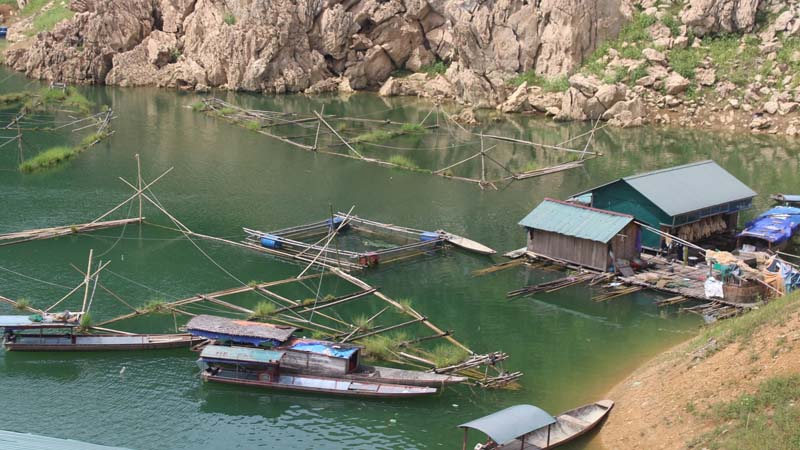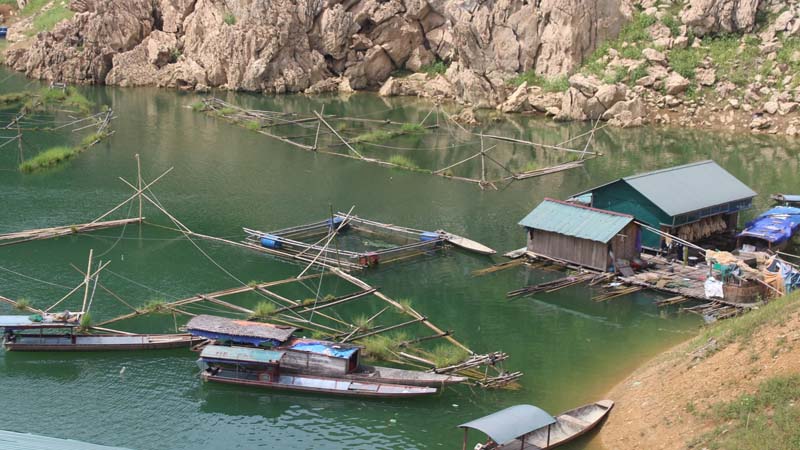
(HBO) - Hoa Binh province has enjoyed stable aquaculture development over the time. It is home to 2,700 ha of aquatic farms and 4,700 fish cages.
The province’s aquatic output hit 686
tonnes in July, including 132 tonnes from fishing and 554 tonnes from fish
farming.
There are 32 aquatic farms and cooperatives
in the province, of which 10 specialise in aquaculture and the remainders combine
agriculture and aquatic activities.
 Residents
in Nua hamlet, Vay Nua commune (Da Bac district) invest in caged fish farming
and fishing on Hoa Binh reservoir to stabilise income.
Residents
in Nua hamlet, Vay Nua commune (Da Bac district) invest in caged fish farming
and fishing on Hoa Binh reservoir to stabilise income.
To stabilise aquaculture, competent
agencies have worked with local authorities to enhance inspection and
dissemination on the negative impact of fishing using explosive, electric currents
and poisons, in an attempt to raise public awareness and responsibility for
aquatic resource protection and development.
They also keep a close watch on weather
conditions on the reservoir, water level and temperature to timely inform
farmers, as well as provide counselling for local people on disease prevention
for fish during seasonal changes./.
According to data from the Hoa Binh Provincial Party Committee, the industrial production index for the first six months of 2025 is estimated to have increased by 20% compared to the same period last year. This marks the highest year-on-year growth rate for this period since 2020.
In the first six months of 2025, Hoa Binh province’s export turnover was estimated at 1.145 billion USD, marking an 18.11% increase compared to the same period in 2024. Import turnover was estimated at $ 804 million, a 17.15% increase, which helped the province maintain a positive trade balance.
The lives of the ethnic minority farmers in Tan Lac district have gradually improved thanks to the new directions in agricultural production. This is a testament to the collective strength fostered through the professional associations and groups implemented by various levels of the district’s Farmers’ Union.
With the motto the "product quality comes first,” after nearly one year of establishment and operation, Muong village’s Clean Food Agricultural and Commercial Cooperative, located in Cau Hamlet, Hung Son Commune (Kim Boi district), has launched reputable, high-quality agricultural products to the market that are well-received by consumers. The products such as Muong village’s pork sausage, salt-cured chicken, and salt-cured pork hocks have gradually carved out a place in the market and they are on the path to obtaining the OCOP certification.
In the past, the phrase "bumper harvest, rock-bottom prices" was a familiar refrain for Vietnamese farmers engaged in fragmented, small-scale agriculture. But today, a new spirit is emerging across rural areas of Hoa Binh province - one of collaboration, organisation, and collective economic models that provide a stable foundation for production.
Maintaining growing area codes and packing facility codes in accordance with regulations is a mandatory requirement for agricultural products to be eligible for export. Recently, the Department of Agriculture and Environment of Hoa Binh province has intensified technical supervision of designated farming areas and packing facilities to safeguard the "green passport" that enables its products to access international markets.



 Residents
in Nua hamlet, Vay Nua commune (Da Bac district) invest in caged fish farming
and fishing on Hoa Binh reservoir to stabilise income.
Residents
in Nua hamlet, Vay Nua commune (Da Bac district) invest in caged fish farming
and fishing on Hoa Binh reservoir to stabilise income.